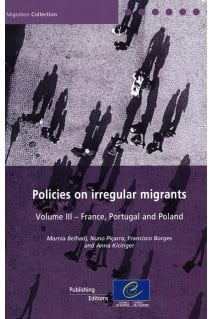



Irregular migrants, who by definition are in an unlawful situation, face insecurity on a daily basis. This prompted the Council of Europe's European Committee on Migration (CDMG) to assess the policy and practice in member states. The aim of the exercise was to identify and evaluate national experiences regarding regularisation proceedings and to draw up proposals for dealing with irregular migration and improving co-operation between countries of origin and host countries.Volumes I and II cover five countries that participated in the first series of evaluations: Armenia, Germany, Greece, Italy and the Russian Federation.Volume III and IV include reports prepared within the second series and cover five other countries: France, Poland, Portugal, Spain and the United Kingdom.
Synthesis report
1. General remarks
2. Country reports
3. Conclusions
France - Exceptional entitlement to residence and return policy
1. Preamble
2. Definition and aims
3. Analysis of aspects of irregular immigration in France
4. Main features of the policy on exceptional entitlement to residence and assisted return
5. Impact of the policy on the influx of irregular migrants
6. Conclusions
7. Bibliographical references
Portugal - Exceptional grant of residence permits to irregular migrants
1. Executive summary
2. Short analysis of irregular migration in Portugal
3. Presentation of the main characteristics of the policy under evaluation
4. Evaluation of the impact of the specific policy on the irregular migration influx and irregular migrants
5. Summary of conclusions
6. Appendices
Poland - Return and regularisation procedures as possible responses to the phenomenon of irregular migration
1. Executive summary
2. Irregular migrants in Poland: brief overview
3. Policy responses to the irregular migration in Poland: return and regularisation measures
4. Evaluation of the impact that return and regularisation measures have on the irregular migrants in Poland
5. Summary of conclusions
6. References
7. Appendix
Download an extract (1000)

Irregular migrants, who by definition are in an unlawful situation, face insecurity on a daily basis. This prompted the Council of Europe's European Committee on Migration (CDMG) to assess the policy and practice in member states. The aim of the exercise was to identify and evaluate national experiences regarding regularisation proceedings and to draw up proposals for dealing with irregular migration and improving co-operation between countries of origin and host countries.Volumes I and II cover five countries that participated in the first series of evaluations: Armenia, Germany, Greece, Italy and the Russian Federation.Volume III and IV include reports prepared within the second series and cover five other countries: France, Poland, Portugal, Spain and the United Kingdom.
Please note that in accordance with our terms & conditions, PDF/epubs may only be purchased by private individuals.
